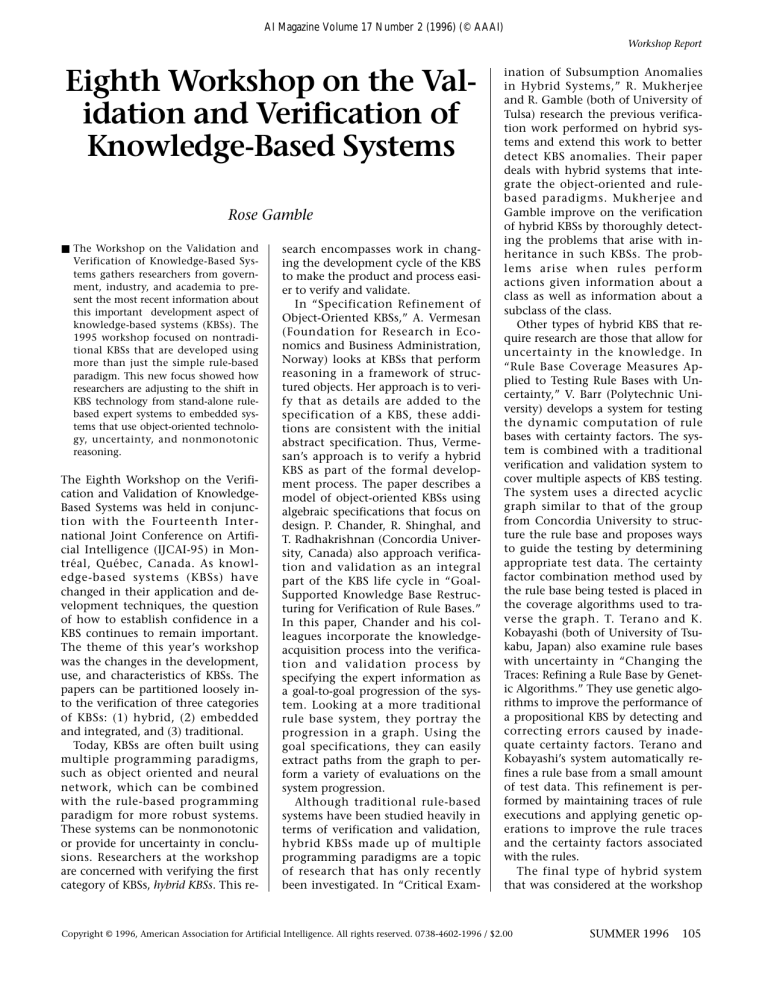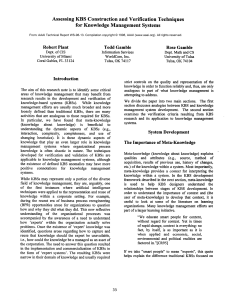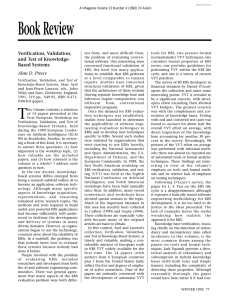
AI Magazine Volume 17 Number 2 (1996) (© AAAI)
Workshop Report
Eighth Workshop on the Validation and Verification of
Knowledge-Based Systems
Rose Gamble
■ The Workshop on the Validation and
Verification of Knowledge-Based Systems gathers researchers from government, industry, and academia to present the most recent information about
this important development aspect of
knowledge-based systems (KBSs). The
1995 workshop focused on nontraditional KBSs that are developed using
more than just the simple rule-based
paradigm. This new focus showed how
researchers are adjusting to the shift in
KBS technology from stand-alone rulebased expert systems to embedded systems that use object-oriented technology, uncertainty, and nonmonotonic
reasoning.
The Eighth Workshop on the Verification and Validation of KnowledgeBased Systems was held in conjunction with the Fourteenth International Joint Conference on Artificial Intelligence (IJCAI-95) in Montréal, Québec, Canada. As knowledge-based systems (KBSs) have
changed in their application and development techniques, the question
of how to establish confidence in a
KBS continues to remain important.
The theme of this year’s workshop
was the changes in the development,
use, and characteristics of KBSs. The
papers can be partitioned loosely into the verification of three categories
of KBSs: (1) hybrid, (2) embedded
and integrated, and (3) traditional.
Today, KBSs are often built using
multiple programming paradigms,
such as object oriented and neural
network, which can be combined
with the rule-based programming
paradigm for more robust systems.
These systems can be nonmonotonic
or provide for uncertainty in conclusions. Researchers at the workshop
are concerned with verifying the first
category of KBSs, hybrid KBSs. This re-
search encompasses work in changing the development cycle of the KBS
to make the product and process easier to verify and validate.
In “Specification Refinement of
Object-Oriented KBSs,” A. Vermesan
(Foundation for Research in Economics and Business Administration,
Norway) looks at KBSs that perform
reasoning in a framework of structured objects. Her approach is to verify that as details are added to the
specification of a KBS, these additions are consistent with the initial
abstract specification. Thus, Vermesan’s approach is to verify a hybrid
KBS as part of the formal development process. The paper describes a
model of object-oriented KBSs using
algebraic specifications that focus on
design. P. Chander, R. Shinghal, and
T. Radhakrishnan (Concordia University, Canada) also approach verification and validation as an integral
part of the KBS life cycle in “GoalSupported Knowledge Base Restructuring for Verification of Rule Bases.”
In this paper, Chander and his colleagues incorporate the knowledgeacquisition process into the verification and validation process by
specifying the expert information as
a goal-to-goal progression of the system. Looking at a more traditional
rule base system, they portray the
progression in a graph. Using the
goal specifications, they can easily
extract paths from the graph to perform a variety of evaluations on the
system progression.
Although traditional rule-based
systems have been studied heavily in
terms of verification and validation,
hybrid KBSs made up of multiple
programming paradigms are a topic
of research that has only recently
been investigated. In “Critical Exam-
ination of Subsumption Anomalies
in Hybrid Systems,” R. Mukherjee
and R. Gamble (both of University of
Tulsa) research the previous verification work performed on hybrid systems and extend this work to better
detect KBS anomalies. Their paper
deals with hybrid systems that integrate the object-oriented and rulebased paradigms. Mukherjee and
Gamble improve on the verification
of hybrid KBSs by thoroughly detecting the problems that arise with inheritance in such KBSs. The problems arise when rules perform
actions given information about a
class as well as information about a
subclass of the class.
Other types of hybrid KBS that require research are those that allow for
uncertainty in the knowledge. In
“Rule Base Coverage Measures Applied to Testing Rule Bases with Uncertainty,” V. Barr (Polytechnic University) develops a system for testing
the dynamic computation of rule
bases with certainty factors. The system is combined with a traditional
verification and validation system to
cover multiple aspects of KBS testing.
The system uses a directed acyclic
graph similar to that of the group
from Concordia University to structure the rule base and proposes ways
to guide the testing by determining
appropriate test data. The certainty
factor combination method used by
the rule base being tested is placed in
the coverage algorithms used to traverse the graph. T. Terano and K.
Kobayashi (both of University of Tsukabu, Japan) also examine rule bases
with uncertainty in “Changing the
Traces: Refining a Rule Base by Genetic Algorithms.” They use genetic algorithms to improve the performance of
a propositional KBS by detecting and
correcting errors caused by inadequate certainty factors. Terano and
Kobayashi’s system automatically refines a rule base from a small amount
of test data. This refinement is performed by maintaining traces of rule
executions and applying genetic operations to improve the rule traces
and the certainty factors associated
with the rules.
The final type of hybrid system
that was considered at the workshop
Copyright © 1996, American Association for Artificial Intelligence. All rights reserved. 0738-4602-1996 / $2.00
SUMMER 1996
105
Workshop Report
is the nonmonotonic KBS, which incorporates default logic into the rulebased reasoning. N. Zlatareva (Central Connecticut State University)
investigates logical inconsistencies,
structural
incompleteness,
redundancies, and intractabilities in
“Verification of Non-Monotonic
Knowledge Bases.” The study is based
on the premise that a belief-revision
facility, such as a truth maintenance
system, joined with a KBS might not
succeed in recovering the possible
knowledge base problems investigated and that new semantic errors can
be introduced through nonmonotonic reasoning. Zlatareva extends her
previous research in contradictiontolerant truth maintenance systems
for distributed verification of nonmonotonic KBSs. Also presenting research on nonmonotonic KBSs was
G. Antoniou (University of Newcastle, Australia). In “Integrity and Rule
Checking in Non-Monotonic Knowledge Bases,” Antoniou focuses on extending established verification and
validation techniques for rule-based
systems to perform integrity checks
and rule checks on rule-based KBSs
that incorporate default logic. His
techniques check rule pairs against
default instances that are incorporated into the reasoning mechanism. An
important aspect of the work is the
modification of the underlying
monotonic inference relation to capture the fact that rules can only forward chain.
Current KBSs have changed in
their underlying use and characteristics. For example, knowledge reuse
and combination have become important when building KBSs. In addition, KBSs can be embedded in other
software systems in which they must
react to changing situations that can
be critical. Because of this thrust, researchers are investigating ways to
combine different KBSs or portions of
a KBS that have been developed by
different experts such that they are
verifiable. W. Gambetta (University
of New South Wales, Australia) addressed the second category of KBS,
embedded and integrated KBSs, in “Obtaining a Compromise View: Verification and Validation Problems in Integrating Knowledge Bases.” The focus
106
AI MAGAZINE
of this research is on the understanding that different KBSs can use different ontologies to describe their concepts, such as with the viewpoints of
different experts. The verification
goal is to develop a model that covers
the maximal-compromise viewpoint.
Gambetta attempts to verify the consistency of the expert knowledge and
the difference in terminology between experts by developing an ontology tree for each viewpoint and
connecting them to form one tree.
Once a single-ontology tree is constructed, more traditional verification
and validation using dependency
graphs can take place.
Additional research in developing
formal methodologies for integrating
KBSs with conventional software was
presented by P. Kiss (Sentar), R. Lewis
(Quality Research), and R. Plant (University of Miami) in “Quick Planner
for Verification and Validation of Distributed Hybrid Systems.” This team
assessed the existing methodologies
and models for developing KBSs and
constructed an overall framework for
integrating conventional and KBS
software into a single distributed system. Within this framework, they
have begun to build a verification and
validation methodology for the integrated system called the QUICK PLANNER.
Verification is much easier to perform on small KBSs. In this regard,
M. Mehrotra (Pragati Synergetic Research) looks at ways to manipulate
very large KBSs into smaller components for verification and validation.
In the final paper in this category,
“Requirements and Capabilities of
the Multi-Viewpoint Clustering Analysis Methodology,” Mehrotra discussed the development of a tool that
discovers multiple, significant structures within large homogeneous KBSs. The premise is that no one single
viewpoint is sufficient to comprehend a complex KBS. The clustering
tool groups rules that share common
properties and identifies the concepts
that underlie these groups using a
two-phase approach: (1) cluster generation and (2) cluster analysis. One
important use of the tool is in embedded KBSs such that, when given
the proper input, clustering can detail which rules are implicitly con-
nected through side effects in external routines.
Although KBSs have undergone
many changes over the years, the
rule-based programming paradigm is
still prevalent. Thus, researchers continue to more deeply investigate issues in the third category of KBSs:
traditional rule-based systems. As more
techniques are developed, the KBS
verification and validation communities look forward to their scalability
and extension to more complex KBSs.
In “Inference Engine Greediness
and Subsumption of Conditions in
Rule-Based Systems,” D. O’Leary (University of Southern California) investigates the need for additional verification testing on a KBS when a
greedy inference strategy is used. Traditional verification and validation of
KBSs does not consider different inference strategies. O’Leary focuses on
subsumption anomalies, detailing
how they are affected with respect to
greediness and how the anomalies
that are detected can be corrected.
Often, researchers find that anomalies previously found in the verification of a KBS are applicable in a setting where a structure similar to a
KBS is used. In “Applying Rule Base
Anomalies to KADS Inference Structures,” F. van Harmelen and M. Aben
(both of University of Amsterdam,
The Netherlands) determine that
many of the same anomalies found
in a developed KBS can be found in
the KADS inference structures. These
inference structures comprise inference steps and knowledge roles. Each
knowledge role represents some domain knowledge, and each inference
step represents the relation between
input knowledge roles and output
knowledge roles. van Harmelen and
Aben represent an inference step as
an analog of a rule, reformulating the
inference step to detect known KBS
verification and validation anomalies.
The final two papers in this category are theoretical in nature. In “A
Tool for Testing Confluence of Production Rules,” J. Schmolze (Tufts
University) and W. Synder (Boston
University) use rewrite rule systems
to investigate their connection to
KBSs. In particular, they have devel-
Workshop Report
oped a tool that automatically tests a
KBS for confluence. Confluence is a
property of rewrite rule systems that,
when combined with termination,
guarantees that unique results are
obtained by the system independent
of the order in which the rules execute. The primary reason for this investigation is that these KBSs are easier to verify because many
verification techniques apply to a
KBS that is both confluent and terminating. L. Laita (Univ. Politécnica
Madrid, Spain) and E. Roanes-Lozano
(Univ. Complutense Madrid, Spain)
construct a Boolean algebra that is
associated with a propositional KBS
in “Verification of Knowledge-Based
Systems: An Algebraic Interpretation.” The algebra allows for the effects of adding rules, facts, and constraints to the KBS so that
consistency is maintained. Their algebraic approach allows them to verify a KBS using REDUCE.
There were two panel sessions at
the workshop. The first panel session
presented information on access to
KBS verification and validation resources. O’Leary led the panel that
included details about a discussion
list, VaVTalk, that researchers can
join by sending e-mail to vavtalk@
cenparmi.concordia.ca. Collections of
papers in this area can be found in
O’Leary (1994), Preece and Suen
(1993), Gupta (1991), and Culbert
(1990).
The second panel session closed
the workshop with a discussion of
the future of the verification and validation of KBSs. Practically, mature
tools are needed that can be commercialized. However, it was agreed that
formal methods of specification and
modeling are also needed to verify
complex KBSs used in critical domains. Additional research is needed
in this area and its integration into
the KBS life cycle.
References
Culbert, C., ed. 1991. Expert Systems with
Applications (Special Issue: Verification and
Validation of Knowledge-Based Systems)
1(3).
Gupta, U. G., ed. 1991. Validating and Verifying Knowledge-Based Systems. Los Alamitos, Calif.: IEEE Computer Society Press.
O’Leary, D., ed. 1994. International Journal
of Intelligent Systems (Special Issue on the
Verification and Validation of Intelligent
Systems—Five Years of AAAI Workshops)
9(8–9).
Preece, A., and Suen, C., eds. 1993. International Journal of Expert Systems (Special
Issue on the Verification and Validation of
Knowledge-Based Systems) 6(2–3).
Rose Gamble is an assistant professor of
computer science in the Department of
Mathematical and Computer Sciences at
the University of Tulsa. Gamble received a
D.Sc. in computer science from Washington University, St. Louis, Missouri. Current
research interests are in formal methods of
verification, knowledge-based system development, and reusability. Gamble was
the co-chair, with C. Landuaer, of the
Eighth Workshop on Validation and Verification of Knowledge-Based Systems.
SUMMER 1996
107



